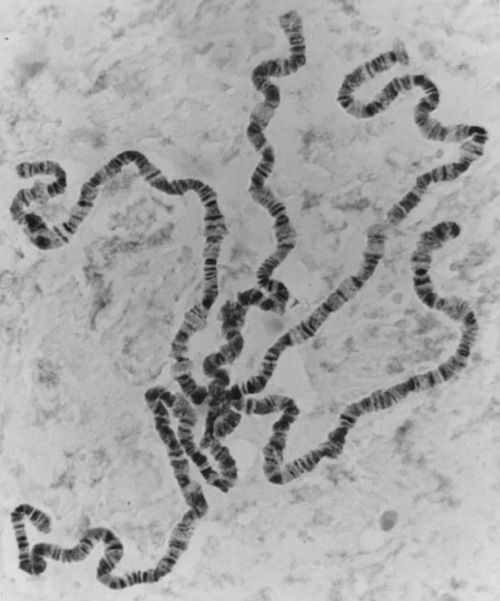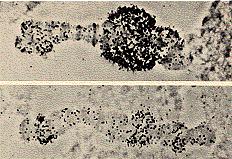| Index to this page |
Endoreplication is the replication of DNA during the S phase of the cell cycle without the subsequent completion of mitosis and/or cytokinesis. (Endoreplication is also known as endoreduplication.)
Endoreplication occurs in certain types of cells in both animals and plants. There are several variations:Cells are polyploid if they contain more than two haploid (n) sets of chromosomes; that is, their chromosome number is some multiple of n greater than the 2n content of diploid cells. For example, triploid (3n) and tetraploid cell (4n) cells are polyploid.
Polyploidy is usually limited to certain tissues in animals, such asPolyploidy is very common in plants.
| Further details of polyploidy — including its role in speciation — are available on a separate page. Link to it. |

The most thoroughly-studied examples of polyteny are the giant chromosomes found in certain cells of larval flies.
The photomicrograph (courtesy of B. P. Kaufmann) shows the polytene chromosomes in a salivary gland cell of a Drosophila melanogaster larva. Such chromosomes are found in other large, active cells as well.
The probable answer: gene amplification. Having multiple copies of genes permits a high level of gene expression; that is, abundant transcription and translation to produce the gene products. This would account for polyteny being associated with large, metabolically active cells (like salivary glands).
Polytene chromosomes are subdivided into some 5,000 dense bands separated by light interbands.
The bands are further subdivided into:The interbands contain regulatory elements — promoters and enhancers — that control the genes in the adjacent gray bands.
Polytene chromosomes also have regions — called "puffs" — that are swollen and appear to have a looser structure.
The exact pattern of puffsThis is just what one would predict if the puffs represent regions of intense gene transcription.
 Top: the autoradiograph shows the puff in chromosome IV of the tiny fly Chironomus tentans after giving ecdysone and radioactive uridine (an RNA precursor). The grains clustered over the puff show that it is a site of intense RNA synthesis.
Top: the autoradiograph shows the puff in chromosome IV of the tiny fly Chironomus tentans after giving ecdysone and radioactive uridine (an RNA precursor). The grains clustered over the puff show that it is a site of intense RNA synthesis.
Bottom: When the antibiotic actinomycin D is given along with ecdysone, puffing is inhibited and little RNA synthesis occurs. Actinomycin D blocks access to DNA by RNA polymerase. (Images courtesy of Claus Pelling, Max-Planck Institute of Biology, Tübingen.)
The pattern of puffing within a cell varies over time. For example, each time an insect larva prepares to molt, a definite, predictable sequence of puffing occurs.
These eight photomicrographs (courtesy of Dr. Michael Ashburner, University of Cambridge) show the changes in the puffing pattern of equivalent segments of chromosome 3 in Drosophila melanogaster over the course of some 20 hours of normal development.

Note that during this period, when the larvae were preparing to pupate, certain puffs formed, regressed, and formed again. However, the order in which they did often differed. For example, in the larva, band 62E becomes active before 63E (c, d, and e), but when pupation begins, the reverse is true (g, h).
In general, early puffs reflect the activation of genes encoding transcription factors. These proteins then bind to the promoters of other genes, turning them on and causing a puff to appear at their loci.
| Welcome&Next Search |